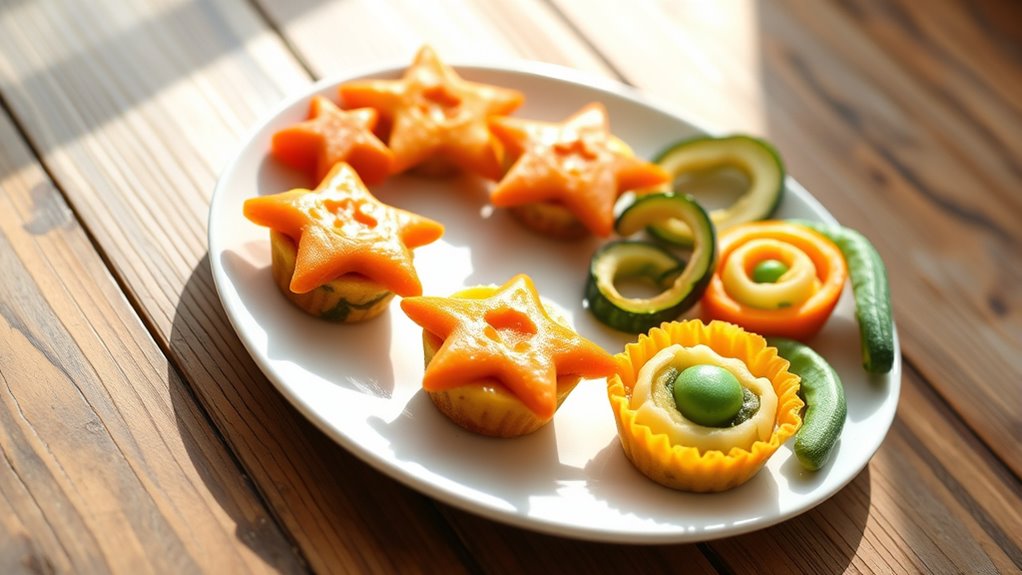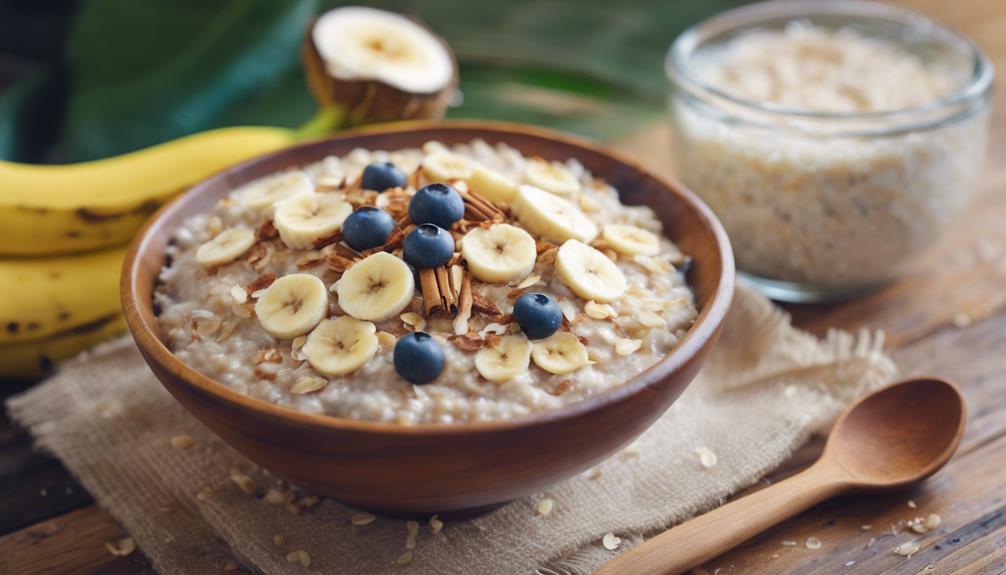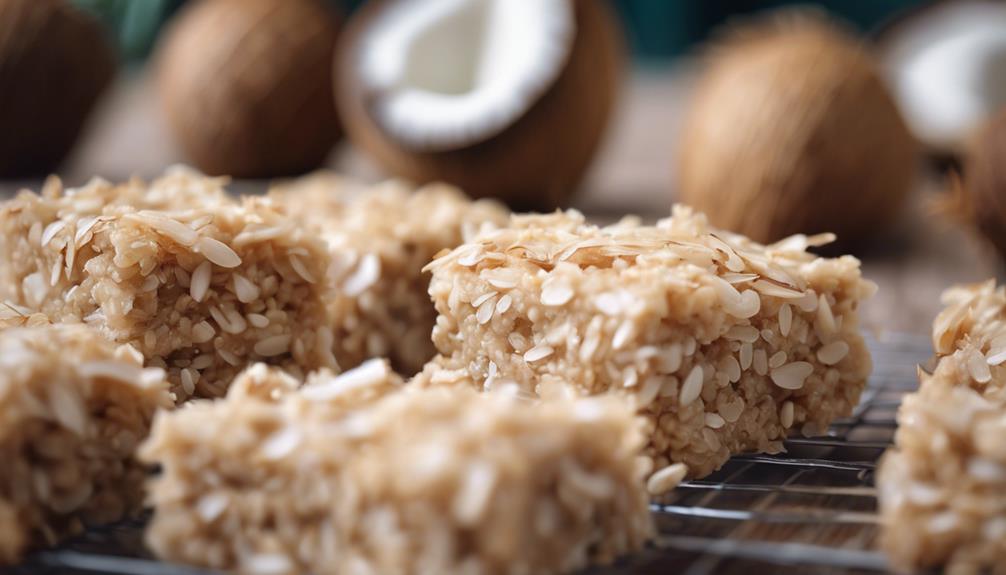To get toddlers to eat veggies they’ll actually enjoy, try fun recipes that hide healthy ingredients in familiar favorites. Blend vegetables like zucchini or carrots into pancakes, pureed sweet potatoes into quesadillas, or add cauliflower to mac and cheese. Use bright colors, playful shapes, and dips to make veggies more appealing. Exploring creative presentation and sneaky techniques can turn mealtime into a positive experience—continue with simple tricks that make veggies irresistible.
Key Takeaways
- Incorporate pureed vegetables into familiar dishes like pancakes, quesadillas, or sauces for seamless nutritional boosts.
- Use colorful veggies blended into smoothies or dips to make them visually appealing and enticing.
- Serve vegetables in fun shapes, small portions, or with dips to increase toddler interest and acceptance.
- Gradually introduce new vegetables alongside favorite foods, offering consistent exposure without pressure.
- Add chopped herbs or colorful garnishes to enhance visual appeal and make veggie-rich meals more inviting.

Getting toddlers to eat enough vegetables can be a challenge, but hiding them in fun recipes makes mealtime easier and more enjoyable. One of your best tools is paying attention to meal presentation. Bright colors, playful shapes, and creative plating can turn even the pickiest eater into a veggie enthusiast. For example, blending spinach or carrots into a smooth sauce and pouring it over pasta gives a vibrant, appealing look that captures your child’s attention. Incorporating vegetables into familiar favorites helps reduce resistance, making mealtime less stressful and more successful.
Brighten mealtime with colorful veggies and fun shapes to win over picky toddlers effortlessly.
When dealing with picky eating strategies, it’s essential to keep things simple and consistent. Offering vegetables in different forms—raw, cooked, pureed—can help find what appeals most. Sometimes, a simple switch from steamed broccoli to crunchy cauliflower florets makes a big difference. The key is to keep trying without pressuring. Kids often need multiple exposures before accepting new flavors, so patience is crucial. You can also involve your toddler in the process by letting them choose or help prepare the meals, which boosts their interest and willingness to try new things.
Another effective technique is to sneak vegetables into recipes your child already loves. For instance, blending zucchini into pancake batter or mixing pureed sweet potatoes into cheese quesadillas turns everyday dishes into veggie-rich meals without fuss. These hidden vegetables are not only nutritious but also add interesting textures and flavors. To make it more fun, you can shape these dishes into playful forms or serve them with colorful dips. This kind of meal presentation transforms what might seem like plain food into a visually appealing and exciting experience.
You can also use creative garnishes to make vegetables more enticing. A sprinkle of chopped herbs or a drizzle of yogurt can turn a simple plate into a vibrant, attractive meal. For younger toddlers, serving vegetables with their favorite dip or in a fun container can make all the difference. The secret is to keep trying different approaches, mixing visual appeal with strategic ingredient hiding, and staying positive. When your child sees meals as a fun adventure rather than a chore, they’re more likely to develop healthy eating habits naturally.
Frequently Asked Questions
How Can I Introduce New Vegetables to Picky Eaters Effectively?
When introducing new vegetables to picky eaters, you can make it easier by offering fruit smoothies packed with hidden veggies they won’t notice. Serve these in colorful plating to catch their eye and make the experience fun. Keep offering a variety of vegetables without pressure, and gradually increase exposure. Consistency and creativity help your little one develop a taste for new flavors, making mealtime less stressful and more enjoyable.
Are There Safe Vegetable Substitutes for Toddlers With Allergies?
You’re wondering if there are safe vegetable substitutes for toddlers with allergies. Yes, you can use alternative produce like zucchini noodles or sweet potato mash as allergy-friendly swaps. These options provide similar textures and flavors without risking allergic reactions. Always check labels and consult with your child’s doctor to ensure the substitutes are safe, and gradually introduce them to see how your little one reacts.
What Are Quick Snack Ideas With Hidden Vegetables for Busy Mornings?
You can make busy mornings easier by whipping up quick snacks like fruit smoothies packed with hidden vegetables and veggie bites. Blend your favorite fruits with spinach or carrots for a nutritious smoothie that kids won’t notice. For a portable option, prepare veggie bites filled with finely chopped veggies and cheese. These snacks are fast, healthy, and perfect for busy mornings, helping your little ones get their veggies without fuss.
How Can I Make Vegetable Preparation More Engaging for Toddlers?
To make vegetable preparation more engaging for toddlers, try using colorful plating to catch their eye and make veggies look fun. Involve them in interactive cooking activities; let them wash, peel, or stir ingredients. This hands-on approach sparks curiosity and makes them more willing to try new flavors. Keep it playful, and soon they’ll associate vegetable prep with enjoyable, bonding moments rather than chores.
What Are the Best Storage Tips for Prepped Hidden Vegetable Ingredients?
You might worry about vegetables spoiling quickly, but with proper storage, they stay fresh longer. Use refrigerator organization to keep prepped ingredients visible and accessible, so you’re encouraged to use them promptly. For longer storage, follow freezer storage tips like portioning vegetables in airtight containers or freezer bags. Label everything clearly, and keep your prep ingredients in designated spots—this makes grabbing hidden vegetables quick and easy for busy days.
Conclusion
Incorporating hidden veggies into toddler meals is a smart way to boost their nutrition—did you know that over 70% of parents struggle to get their kids to eat enough vegetables? By sneaking them into fun recipes, you make mealtime easier and healthier. Keep experimenting with these creative ideas, and watch your little one develop a taste for veggies without a fuss. It’s a win for both of you—delicious, nutritious, and stress-free!










